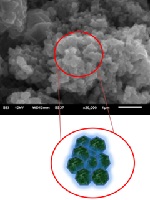
Synthesis and Characterization of Polyaniline/CuO Nanocomposites with Various Temperature
Abstract
Keywords
Full Text:
PDFReferences
[1] K. Lata and R. K. Rana, “Synthesis and characterization of polyaniline-copper oxide nano-composites,” Int J Chem Stud, vol. 12, no. 1, pp. 46–50, Jan. 2024,
doi:10.22271/chemi.2024.v12.i1a.12396.
[2] Asha et.al., “Synthesis and characterization of polyaniline/TiO2 composites,” Indian journal of pure and app Physics, vol. 52, pp. 341-347, May 2014.
[3] F. R. Rangel-Olivares et.al., “Synthesis and characterization of polyaniline-based polymer nanocomposites as anti-corrosion coatings,” Coatings, vol. 11, no. 6, Jun. 2021,
doi: 10.3390/coatings11060653.
[4] S. L. Goyal et.al., “Synthesis and characterization of polyaniline/TiO2 composites,” Indian journal of pure and app Physics, vol. 52, pp. 341-347, May 2014.
[5] A. Mostafaei and A. Zolriasatein, “Synthesis and characterization of conducting polyaniline nanocomposites containing ZnO nanorods,” Progress in Natural Science: Materials International, vol. 22, no. 4, pp. 273–280, Aug. 2012,
doi: 10.1016/j.pnsc.2012.07.002.
[6] L. Yesappa et.al., “Characterization, Electrical Conductivity and Electrochemical Performance of Polyaniline-LiClO4-CuO Nano Composite for Energy Storage Applications,” Polymer-Plastics Technology and Materials, vol. 58, no. 2, pp. 193–205, Jan. 2019,
doi:10.1080/03602559.2018.1466175.
[7] N. Boutaleb et.al., “Facile Synthesis and Electrochemical Characterization of Polyaniline@TiO2-CuO Ternary Composite as Electrodes for Supercapacitor Applications,” Polymers (Basel), vol. 14, no. 21, Nov. 2022,
doi: 10.3390/polym14214562.
[8] D. Doğan et.al., “Increasing Photocatalytic Stability and Photocatalytic Property of Polyaniline Conductive Polymer,” Iran J Sci Technol Trans A Sci, vol. 44, no. 4, pp. 1025–1037, Aug. 2020,
doi: 10.1007/s40995-020-00922-3.
[9] R. R. Sunarya et.al., “Combination of polyaniline and graphene oxide as counter electrode composites in dye-sensitized solar cells,” in AIP Conference Proceedings, American Institute of Physics Inc., Apr. 2023.
doi: 10.1063/5.0115886.
[10] A. I. Fatya et.al., “Synthesis of polyaniline/electrochemically exfoliated graphene composite as counter-electrode in dye-sensitized solar cell,” Polymer-Plastics Technology and Materials, vol. 59, no. 12, pp. 1370–1378, Aug. 2020,
doi:10.1080/25740881.2020.1738479.
[11] R. R. Sunarya et.al., “Electrocatalytic Activation of a DSSC Graphite Composite Counter Electrode Using In Situ Polymerization of Aniline in a Water/Ethanol Dispersion of Reduced Graphene Oxide,” J Electron Mater, vol. 49, no. 5, pp. 3182–3190, May 2020,
doi: 10.1007/s11664-020-07977-3.
[12] N. Fauziah et.al., “Ultrasonication-modified electrochemically exfoliated graphene for counter electrode in dye-sensitized solar cells,” Carbon Trends, vol. 12, Sep. 2023,
doi: 10.1016/j.cartre.2023.100292.
[13] R. Rahmawati et.al., “Reduced Graphene Oxide/Polyaniline Nanocomposite as Efficient Counter Electrode for Dye Sensitized Solar Cells,” in IOP Conference Series: Materials Science and Engineering, Institute of Physics Publishing, Jul. 2018.
doi:10.1088/1757899X/384/1/012040.
[14] H. Meskher et.al., “Synthesis and Characterization of CuO@PANI composite: A new prospective material for electrochemical sensing,” Journal of Composites and Compounds, vol. 4, no. 13, pp. 178–181, Dec. 2022,
doi: 10.52547/jcc.4.4.1.
[15] M. Nagaraja et.al, “Polyaniline-CuO nanocomposite: Electrical, structural and sensor properties,” in Materials Today: Proceedings, Elsevier Ltd, 2021, pp. 1989–1992.
doi: 10.1016/j.matpr.2021.08.154.
[16] L. G. Yesappa et.al., “Structure, morphology and optical properties of CuO nano particles immersed PANI/Li composite,” in AIP Conference Proceedings, American Institute of Physics Inc., Jun. 2020.
doi: 10.1063/5.0009090.
[17] S. Ashokan et.al., “Synthesis and characterization of CuO nanoparticles, DBSA doped PANI and PANI/DBSA/CuO hybrid composites for diode and solar cell device development,” J Alloys Compd, vol. 646, pp. 40–48, Jun. 2015,
doi: 10.1016/j.jallcom.2015.05.088.
[18] X. M. He et.al., “Facile synthesis of polyaniline-coated SiO2 nanofiber and its application in enrichment of fluoroquinolones from honey samples,” Talanta, vol. 140, pp. 29–35, Aug. 2015,
doi: 10.1016/j.talanta.2015.03.006.
[19] S. Islam et.al., “Synthesis, electrical conductivity, and dielectric behavior of polyaniline/V2O5 composites,” Int J Polym Sci, vol. 2013, 2013,
doi: 10.1155/2013/307525.
[20] R. Li et.al., “Intercalated polyaniline in V2O5 as a unique vanadium oxide bronze cathode for highly stable aqueous zinc ion battery,” Energy Storage Mater, vol. 38, pp. 590–598, Jun. 2021,
doi: 10.1016/j.ensm.2021.04.004.
[21] Z. A. Boeva and V. G. Sergeyev, “Polyaniline: Synthesis, properties, and application,” Polymer Science - Series C, vol. 56, no. 1, pp. 144–153, 2014,
doi: 10.1134/S1811238214010032.
[22] V. Babel and B. L. Hiran, “A review on polyaniline composites: Synthesis, characterization, and applications,” Jul. 01, 2021, John Wiley and Sons Inc.
doi: 10.1002/pc.26048.
[23] F. Fenniche et.al., “Synthesis and characterization of PANI nanofibers high-performance thin films via electrochemical methods,” Results Chem, vol. 4, Jan. 2022,
doi: 10.1016/j.rechem.2022.100596.
[24] M. Reza et.al., “Variation of Ammonium Persulfate Concentration Determines Particle Morphology and Electrical Conductivity in HCl Doped Polyaniline,” in IOP Conference Series: Materials Science and Engineering, Institute of Physics Publishing, Sep. 2019.
doi:10.1088/1757899X/599/1/012002.
[25] A. N. Amalina et.al., “Preparation of polyaniline emeraldine salt for conducting-polymer-activated counter electrode in Dye Sensitized Solar Cell (DSSC) using rapid-mixing polymerization at various temperature,” Bulletin of Chemical Reaction Engineering and Catalysis, vol. 14, no. 3, p. 521, 2019,
doi: 10.9767/bcrec.14.3.3854.521-528.
[26] Q. Zhang et.al., “CuO nanostructures: Synthesis, characterization, growth mechanisms, fundamental properties, and applications,” 2014, Elsevier Ltd. doi: 10.1016/j.pmatsci.2013.09.003.
[27] S. Raja and M. Deepa, “Synthesis and characterization of polyaniline-copper (II) oxide nanocomposite by wet chemical route,” Indian Journal of Advanced Chemical Science, vol. 3, pp. 198–203, 2015.
[28] L. I. Nadaf and K. S. Venkatesh, “Polyaniline-Copper Oxide Nano-Composites: Synthesis and Characterization,” Material Science Research India, vol. 12, no. 2, pp. 108–111, Dec. 2015,
doi: 10.13005/msri/120204.
[29] D. Manyasree et.al., “CuO nanoparticles: Synthesis, characterisation and their bactericidal efficacy,” International Journal of Applied Pharmaceutics, vol. 9, no. 6, pp. 71–74, Oct. 2017,
doi: 10.22159/ijap.2017v9i6.71757.
[30] W. Sun et.al., “Hierarchically porous hybrids of polyaniline nanoparticles anchored on reduced graphene oxide sheets as counter electrodes for dye-sensitized solar cells,” J Mater Chem A Mater, vol. 1, no. 8, pp. 2762–2768, Feb. 2013,
doi: 10.1039/c2ta01000c.
[31] K. A. Ibrahim, “Synthesis and characterization of polyaniline and poly(aniline-co-o-nitroaniline) using vibrational spectroscopy,” Arabian Journal of Chemistry, vol. 10, pp. S2668–S2674, May 2017,
doi: 10.1016/j.arabjc.2013.10.010.
[32] Y. Kovalyshyn et.al., “Synthesis and Electrochemical Properties of Polyaniline Composites,” in Proceedings of the 2020 IEEE 10th International Conference on “Nanomaterials: Applications and Properties”, NAP 2020, Institute of Electrical and Electronics Engineers Inc., Nov. 2020.
doi:10.1109/NAP51477.2020.9309531.
Refbacks
- There are currently no refbacks.








